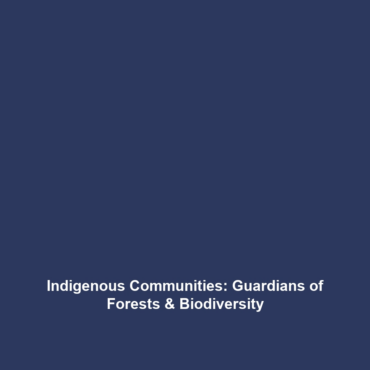Indigenous Communities: Key Players in Forest Protection and Biodiversity Conservation
Introduction
Understanding the role of local communities, particularly indigenous groups, in forest protection and biodiversity conservation is crucial in the context of ongoing deforestation and biodiversity loss. These communities have intrinsic knowledge and sustainable practices that have sustained ecosystems for generations. As deforestation ramps up globally, recognizing the significance of indigenous stewardship is essential for preserving vital habitats and combating biodiversity loss. This article delves into the importance of indigenous communities as pivotal players in such environmental efforts.
Key Concepts
Indigenous Knowledge and Practices
Indigenous communities possess traditional ecological knowledge (TEK) that enhances conservation strategies. This knowledge encompasses the understanding of local flora and fauna, seasonal changes, and sustainable resource management. Their practices often align with modern conservation principles, making them invaluable in addressing deforestation and biodiversity loss.
Community-Led Conservation
Community-led initiatives often demonstrate success in conservation outcomes compared to top-down approaches. Empowering local communities fosters ownership and accountability, resulting in more effective forest protection. Such efforts not only curb deforestation but also promote biodiversity, highlighting the indispensable role of local and indigenous populations.
Applications and Real-World Uses
This section explores how local communities, particularly indigenous groups, are key players in forest protection and biodiversity conservation within the wider issue of deforestation and biodiversity loss.
Community Forestry Initiatives
One notable application is community forestry programs that allow local populations to manage and protect forest resources. These initiatives serve as a model for integrating indigenous knowledge, demonstrating how engaging communities can lead to effective wildlife management and forest conservation. For example, in countries like Nepal, community forestry has led to the regeneration of degraded forests, showcasing the positive impact of local stewardship on biodiversity.
Cultural Preservation and Biodiversity
Preserving cultural practices among indigenous groups directly corresponds to biodiversity conservation. Many traditions foster a deep respect for nature, illustrating how indigenous engagement creates win-win scenarios for both culture and ecology.
Current Challenges
Despite their significant contributions, there are challenges facing local and indigenous communities in the realm of forest protection. These challenges include:
- Land Rights Issues: Indigenous rights to land are often overlooked, leading to conflicts over resources.
- Climate Change: Increasingly erratic weather impacts traditional practices and biodiversity.
- Economic Pressures: Development projects may undermine indigenous conservation efforts.
Future Research and Innovations
Research is ongoing to explore the integration of traditional ecological knowledge with scientific approaches. Innovations such as remote sensing technology and participatory mapping could enhance the effectiveness of conservation strategies. Investment in capacity-building initiatives for indigenous groups is proving essential in empowering them to advocate for their rights and preserve biodiversity.
Conclusion
Local communities, especially indigenous groups, are integral to forest protection and biodiversity conservation efforts. Their traditional knowledge and practices provide valuable insights into sustainable environmental stewardship necessary to combat deforestation and biodiversity loss. It is imperative to support these communities through policy changes and capacity-building initiatives to ensure their role in conservation is recognized and valued.
For further reading on how conservation strategies can benefit from indigenous knowledge, visit our articles on Traditional Ecological Knowledge and Community Forestry Initiatives.

Leave a Reply